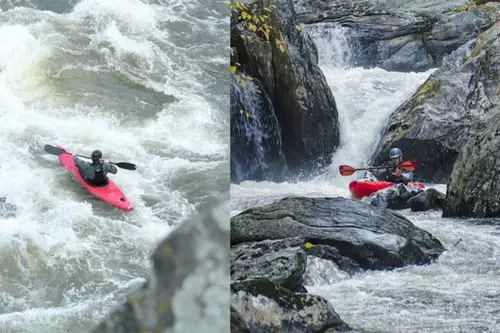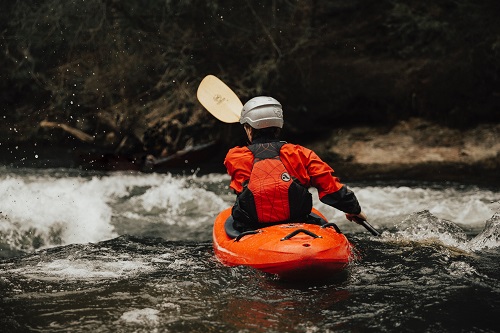If you’re new to whitewater kayaking, you might wonder what is the difference between paddling in a river and a creek. The body of water in which you kayak will highly influence the boat you need and your overall experience. So let’s compare creeking to river running!
Creeks are generally smaller than rivers, which can make them steeper and more technical. So a creek boat needs more rocker to turn quickly and boof easily. It also has more volume to resurface after a drop. On the other hand, river runners are designed for speed, stability, and playfulness in big water.

In short, that’s why creeking and river running are different. The environment, boat, and features are unique to the type of whitewater you’re kayaking in. Now let’s explore all those details about paddling in creeks and rivers!
Creeks VS Rivers
Although there’s not much difference between a river and a creek, according to the United States Geological, we use them for different situations. They are both flowing water, but we tend to use the term river when it’s large and creek when it’s small.
So the main difference between rivers and creeks is the size of the waterway. Rivers are larger than creeks and involve more water. On the other hand, creeks are narrower, shallower, and steeper than rivers.
Creekers VS River Runners | Whitewater Kayaks
Since rivers and creeks aren’t exactly the same, they require different boats. There are 4 main types of whitewater kayaks: Creekers, River Runners, Playboats & Long Boats. But for today, let’s focus on the creek and river runner kayaks, the two main categories for paddling downriver.
What Is A Creeker?
A creeker, also called a creek boat, is a whitewater kayak designed for creeks. With a lot of rocker for better maneuverability and easier boofing*, it’s ideal for narrow, steep, and technical rapids. Creekers also typically have a high volume to resurface quickly after steep drops.
*Boofing: It’s a technique that consists of keeping the front of the boat (bow) out of the water to carry more speed and avoid obstacles.
What Is A River Runner?
A river runner is a whitewater kayak designed for going down large and high-flow rapids. It generally tracks relatively well for speed and has a flatter hull for stability and surfing. It’s a very versatile whitewater boat for running rivers.
So, What Is The Difference Between A Creeker And A River Runner?
A creeker is designed for creeks, while a river runner is made for rivers. So a creek boat generally has more rocker and volume because it needs to turn quickly and resurface after steep drops. On the other hand, a river runner will allow you to go faster, feel more stable, catch eddies, and surf in rapids.
Hull Shape
The hull is the bottom shape of the kayak. There are two main types of hulls: Displacement & Planing Hulls. Displacement hulls are round while planing ones are flat. Creek boats tend to have a displacement or more rounded hull, while river runners usually have a planing or flatter hull.
But both whitewater kayak types can have either one or a mix of those hull designs. A displacement hull will generally be faster while going downstream and offer more secondary stability*. The rounded bottom also dissipates the impact on big drops, which is ideal for creeks.
Planing hulls are more appropriate for surfing while running rivers. The flat bottom of the kayak is perfect for planing on waves. They also accelerate quickly but require more effort to maintain speed than displacement hulls. Planing hulls usually come with sharper edges, which makes them track better and easier to catch eddies.
*Secondary stability means it’s more stable when leaning on the edges of the boat.
Rocker
The rocker is the curvature from the back (stern) to the front (bow) end of the kayak. That will determine how much of the kayak hull is in the water, also called the effective waterline. So it will influence how it reacts and performs in whitewater.
The higher the rocker, the more maneuverability and control you have on the boat. So you will be able to perform quick turns and navigate technical rapids. That’s why creekers generally have a high rocker.
On the other hand, kayaks with a lower rocker tend to track better and go faster but don’t turn as quickly and easily. So it’s better for big water because you need speed to paddle through huge waves and holes. That’s why most river runners have a low rocker.
Where the rocker starts also impacts the boat’s performance on the water. If it begins close to the middle (continuous rocker), it will boof easily and increase maneuverability. If it suddenly rises close to the ends of the kayak (kick rocker), it’s better for speed, tracking, and surfing.
So creek boats generally have a continuous rocker, while river runners have a kick rocker. Creekers also tend to have a sharper curvature (progressive rocker), which makes them more appropriate for steep drops. River runners usually have a softer curvature (linear rocker).
You can learn more about the different rockers and their impact on the paddling experience in this article from Blister Review.
Volume
The volume is another aspect on which creekers and river runners differ. As I already told you, creek boats generally have more volume to resurface quickly after dropping in the water. But the volume distribution will also affect its performance.
River runners have most of the volume around the cockpit. That allows the paddler to have more control over the overall boat and perform dynamic moves or tricks. It also increases maneuverability and stability while surfing.
On the other hand, the volume of creekers is more distributed into the stern and bow of the kayak. It allows them to resurface faster and in a more stable way. Boats with a higher volume on the front and back also tend to pass over holes instead of going through them.
Should You Buy A Creek Boat or A River Runner?
The whitewater kayak you should choose will mainly depend on where you plan to use it. If you want to go in creeks, waterfalls, and technical rapids, a creeker will be more appropriate. On the other hand, river runners are more versatile and would be ideal for large rivers and big water.
But you can use a creek boat in a river or vice-versa. It will just not perform as well as a kayak designed for this environment. So most people should opt for a river runner, except for advanced paddlers that plan to mainly paddle in very steep, narrow, and technical rapids.
Creeking VS River Running | Paddling Experience
The difference between paddling in creeks and running rivers, is the type of rapids you will find. Creeking involves tight, steep, and technical rapids, which often means waterfalls. On the other hand, river running is done in large rivers, involving holes and waves where you can surf.
Last Thoughts About Kayaking In Rivers & Creeks!
Finally, creeking is all about steep drops and technical rapids, while river running is more about big water with holes and waves. Creek boats have more rocker, volume, and a rounded hull, while river runners have a flatter hull for planing, tracking, and catching eddies.

So each kayak is designed for the type of environment in which it’s intended to be used. If you’re just getting started with whitewater kayaking, you should probably stick to running rivers. But if you have enough experience and skills, you could try going down creeks for steeper and more technical rapids.
See You On The River!
